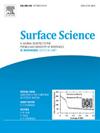Single atom alloys 2.0: Exploiting undercoordination for stronger dissociative CH4 chemisorption
IF 1.8
4区 化学
Q3 CHEMISTRY, PHYSICAL
引用次数: 0
Abstract
Efficient C![]() H bond activation is key to low temperature methane oxidation in catalytic converters of natural gas-powered vehicles. Through ab initio calculations, we investigate the potential enhancement of dissociative CH₄ chemisorption on single atom doped (211) facets of Pt and Pd, the preferred platinum group metals (PGMs) for methane oxidation. Single atom doping at undercoordinated edge sites induces surface relaxation, leading to stronger methane dissociation energies due to dopant-induced expansive lattice strain. Conversely, geometrically restricted subsurface doping imposes compressive strain, resulting in weaker chemisorption energies. Our findings indicate that the d-band model fails to capture these strain-dominated activity trends at single-atom sites. Although subsurface sites are thermodynamically stable for single atom doping under inert conditions, dopant segregation to exposed edge sites becomes more favorable when dissociated methane is chemisorbed on the surface. This study adds a new dimension to the design of single-atom alloy catalysts and encourages experimental efforts to synthesize edge-doped dilute single-atom PGM alloys for enhanced CH₄ activation.
H bond activation is key to low temperature methane oxidation in catalytic converters of natural gas-powered vehicles. Through ab initio calculations, we investigate the potential enhancement of dissociative CH₄ chemisorption on single atom doped (211) facets of Pt and Pd, the preferred platinum group metals (PGMs) for methane oxidation. Single atom doping at undercoordinated edge sites induces surface relaxation, leading to stronger methane dissociation energies due to dopant-induced expansive lattice strain. Conversely, geometrically restricted subsurface doping imposes compressive strain, resulting in weaker chemisorption energies. Our findings indicate that the d-band model fails to capture these strain-dominated activity trends at single-atom sites. Although subsurface sites are thermodynamically stable for single atom doping under inert conditions, dopant segregation to exposed edge sites becomes more favorable when dissociated methane is chemisorbed on the surface. This study adds a new dimension to the design of single-atom alloy catalysts and encourages experimental efforts to synthesize edge-doped dilute single-atom PGM alloys for enhanced CH₄ activation.

单原子合金2.0:利用欠配位获得更强的离解CH4化学吸附
高效活化CH键是实现天然气动力汽车催化转化器低温甲烷氧化的关键。通过从头计算,我们研究了甲烷氧化首选铂族金属(PGMs)铂和钯的单原子掺杂(211)面离解CH₄化学吸附的潜在增强。在欠配位边缘位置掺杂单原子导致表面松弛,由于掺杂引起的膨胀晶格应变导致甲烷解离能增强。相反,几何限制的亚表面掺杂施加压缩应变,导致较弱的化学吸附能。我们的研究结果表明,d波段模型未能捕捉到这些菌株主导的单原子活性趋势。虽然在惰性条件下,单原子掺杂的亚表面位置是热力学稳定的,但当游离甲烷在表面化学吸附时,掺杂剂向暴露边缘位置的偏析变得更加有利。本研究为单原子合金催化剂的设计增加了一个新的维度,并鼓励实验努力合成边缘掺杂稀单原子PGM合金以增强CH₄活化。
本文章由计算机程序翻译,如有差异,请以英文原文为准。
求助全文
约1分钟内获得全文
求助全文
来源期刊

Surface Science
化学-物理:凝聚态物理
CiteScore
3.30
自引率
5.30%
发文量
137
审稿时长
25 days
期刊介绍:
Surface Science is devoted to elucidating the fundamental aspects of chemistry and physics occurring at a wide range of surfaces and interfaces and to disseminating this knowledge fast. The journal welcomes a broad spectrum of topics, including but not limited to:
• model systems (e.g. in Ultra High Vacuum) under well-controlled reactive conditions
• nanoscale science and engineering, including manipulation of matter at the atomic/molecular scale and assembly phenomena
• reactivity of surfaces as related to various applied areas including heterogeneous catalysis, chemistry at electrified interfaces, and semiconductors functionalization
• phenomena at interfaces relevant to energy storage and conversion, and fuels production and utilization
• surface reactivity for environmental protection and pollution remediation
• interactions at surfaces of soft matter, including polymers and biomaterials.
Both experimental and theoretical work, including modeling, is within the scope of the journal. Work published in Surface Science reaches a wide readership, from chemistry and physics to biology and materials science and engineering, providing an excellent forum for cross-fertilization of ideas and broad dissemination of scientific discoveries.
 求助内容:
求助内容: 应助结果提醒方式:
应助结果提醒方式:


